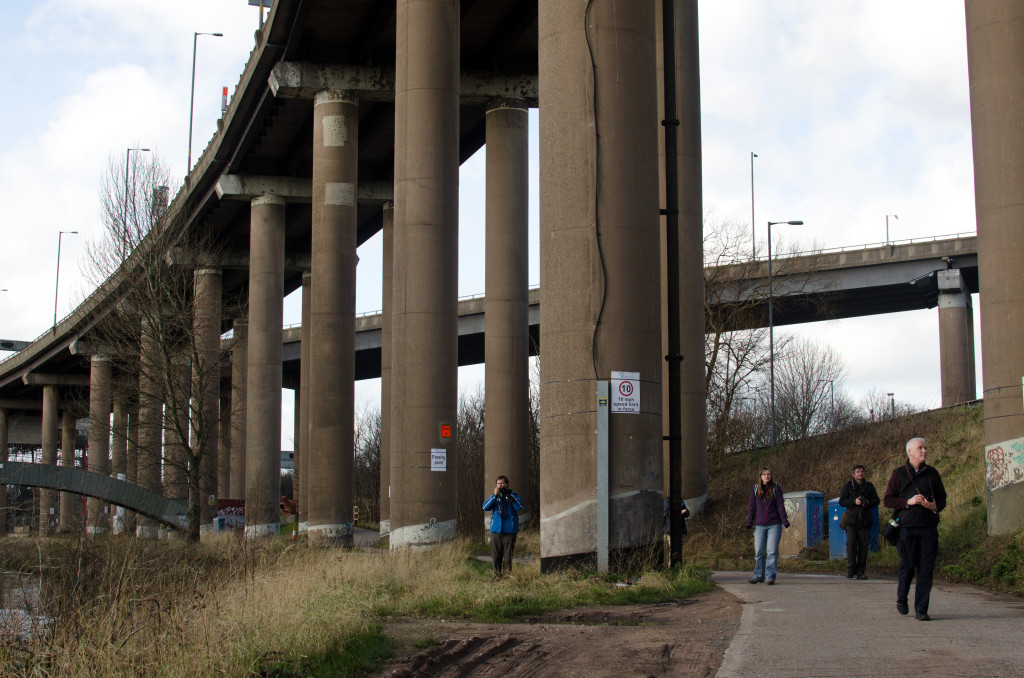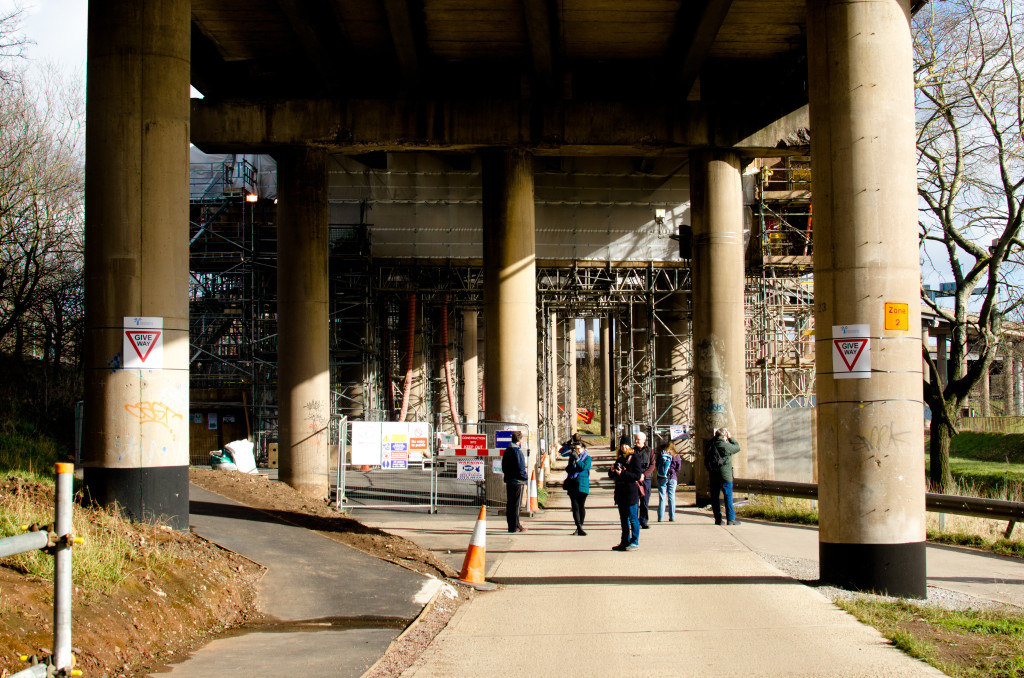
I’m preparing my presentation for Bees In A Tin on Friday about the walks I ran with sound artists last November which will form the core of my documentation of those events. At the Spaghetti Junction photo walk on Sunday I got talking to one of the participants about how leading these walks was really my “work” in an artistic sense. This evening I submitted an idea to a performance arts festival looking at the connection between performance and photography. Meanwhile the Walk On exhibition, which I blogged about the catalogue for last year, has finally made its way to the MAC arts centre down the river from me, though I haven’t had a chance to visit yet.
So it’s probably a good time to explain how leading people with cameras on walks through Birmingham is, for me, a Work of Art.
When I lead people on a walk it’s very obviously a performance. I have a script, both in terms of the route I plan to take and the manner in which I present that route. I have a role, that of the expert, the guide, and I play that role as a character quite similar to Pete Ashton but different enough that friends have commented on it.
The whole event is mediated by my decisions. The participants have their experience directed and informed by me. I decide what they see and, more critically, how they see it.
This second part is the most interesting and I’d like to address it on a number of levels.

Firstly there’s the photographic aspect. The Photo Walk is sold as a chance to experience the city as a “photographer” rather than a normal pedestrian. We walk slowly. We look up and down. We use the camera as a tool to record but also understand the environment. Mindful photography is a creative endeavour and we are creatively engaging with the environment, making small rectangular artworks from our experience. Sure, most of these artworks aren’t going to set the world on fire, but that’s the same with everything. The point is I am asking people to think about what they are walking through in these terms.
Secondly there’s the narration. I tend to be quite hands off on the walks, letting people drift and discover on their own, but I make a point to bring people together for key moments. Some of it is historical context (Curzon St Station always makes for a good story), sometimes it’s a creative exercise (really look at an object and count to 50 before photographing it), sometimes it’s drawing attention to details (I like to point out the rusting metal embedded in buildings as evidence of previous uses) but often it’s more subtle that that.
I also, and I guess this is Thirdly, set a vibe. When leading people through Digbeth or Spaghetti Junction I am often taking them to places they haven’t been to. There’s a sense of an adventure into the unknown and it’s something I have to be very careful to manage. Being photographers with relatively expensive equipment my groups often have a middle-class privilege bias to them and I tend to take them to industrial and post-industrial areas. I am constantly aware of the spectre of class tourism and ruin porn and try my best to mitigate this by showing respect for the areas we’re in. On Sunday I tried to emphasise that people live in the shadows of Spaghetti Junction and that this definitely isn’t an abandoned wasteland. Indeed, the structure looks like it does so as to cause minimal destruction underneath. It should be seen as a monumental piece of architecture which offers fantastic opportunities for photography, but also as a part of this city that, for good or ill, informs the lives of the people that live in it.

Of course I can’t control how someone sees these things. When I commented on a women wearing an incredibly striking yellow dress on a Sunday lunchtime in Digbeth I was told by one of my walkers she was definitely a prostitute, something which had never occurred to me and for which I saw no evidence. And even if she was, so what? Another time an older man found my tour of the more run-down areas around Bradford St to be depressing, which was a perfectly valid viewpoint which I sympathise, particularly as he’d worked in Birmingham when these areas were vibrant and alive. I wanted him to see it from my perspective, that there was beauty in the history that was revealed by this decay, but his feelings were too strong.
Still, not being able to control your participants is not a failure. If anything I welcome these challenges because they make me reconsider my prejudices, my perspectives. But even if they reject my framing, the framing still dominates. This is MY walk.
So, that’s the performance bit covered. But what about the artwork? Where does that fit it?
There’s a view that the walk itself is the work. I perform for 90 minutes to a small participatory audience and then we all go home. I think this view has merit, but I don’t think it makes for very interesting art. For a start you could say teaching is an artwork. People gather in a room where the teacher performs and they leave with their worldview slightly changed. Is this fundamentally any different to seeing a play in a theatre? I don’t know, to be honest, so I’ll leave that one for the “theatre in education” folks to answer.
I do know I play the same character when I’m teaching as when I’m leading a walk, and that my ability to be “a photographer” is diminished when I’m in this role. Photography, for me, is a personal process that edges into meditative at times. I find I cannot take decent photos while I’m running a workshop or a walk because I cannot get into the right mindset. (Amusingly I have no decent photos of Curzon St Station despite telling over 100 people how to take decent photos of it.) So I’d be happy to go along with the notion that my taking people through this process is, in some way, a “work of art”.

But these are more than guided walks. They are more than classes. People are taking photographs, engaging in creative activities which have outcomes in the form of photographs. This is where I think I am being an Artist creating a Work, not as the producer of a walk but as a director of other people’s photographs.
I like to think of a Photo Walk as a group of cameras attached to people over whom I exert an amount of control. I use the methodology of the tour guide to broker a situation where people are prepared to let me control their lives for a short period. As such any photographs that emerge from this process are, in some way, informed by me. I can consider the mass of photos that emerge from these walks to be “the work”. That is, if I can get hold of them.
Photography, for me, is about working with constraints. There are obvious physical constraints such as where you can place the camera. Natural constraints of light and technical constraints of the equipment used. There’s also the constraint of photography itself - the issue of thinking in terms of a rectangle of coloured dots instead of with your eyes. All these problems serve to make photography a vibrant and exciting artistic medium.
So the idea of attempting to influence a dozen or so autonomous agents in how they might take photographs and the results being “my art” is not a strange one. An important part of art, for me, is understanding when to exert control and when to just let it be. When to influence and when to not. It’s about developing an understanding of the subject and developing a relationship. My subject is the areas I lead walks in but also how those areas are perceived. Evidence of that perception is often the work.
Or at least that’s the mental framework I’m currently approaching these walks with. It’s working so far.

Photos by Fiona Cullinan, Steve Cooper and Myself.






